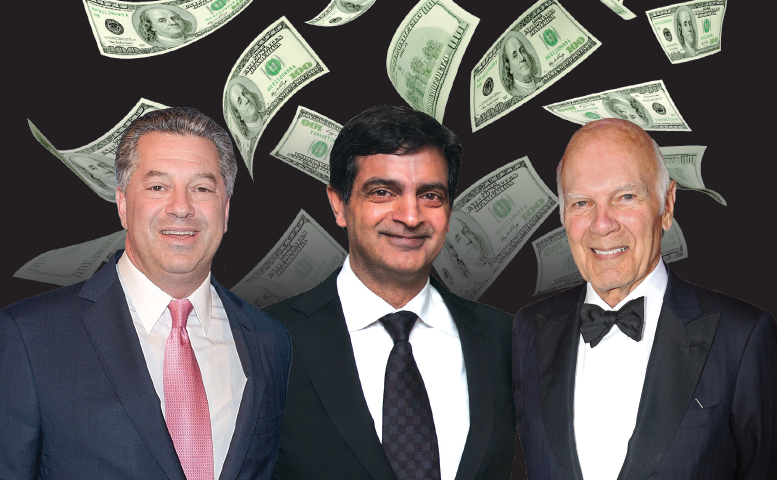Trending
The big pay paradox
CEOs of publicly traded real estate firms are getting major pay bumps — even as stocks tank and shareholders lose billions

It’s a rough time to be an investor in a public real estate company, but a great time to be the CEO of one.
Even as stock prices at several major firms tumbled over the past year — costing shareholders billions — senior executives at major commercial real estate firms continued to earn fat paychecks and stock options, a review of public filings by The Real Deal found.
SL Green Realty CEO Marc Holliday easily defended his title as the highest-paid chief executive of a major office REIT with a $17.41 million compensation package in 2017. While that’s down from the $23 million he took home in 2015, it’s more than Holliday earned in 2016, or between 2012 and 2014, when SL Green’s stock performed much better.
Related: Sizing up real estate’s big earners
Vornado Realty Trust CEO Steve Roth’s $10.47 million compensation in 2017 was down slightly from a year earlier, though it was still higher than in the four years prior. And Boston Properties’ Owen Thomas earned just over $10 million, his biggest paycheck in six years.
Among the top earners on the retail side, Sandeep Mathrani, former CEO of General Growth Properties — which Brookfield Property Partners acquired in August for $15 billion — took home more than $11 million in his last full year at the helm. That was down from the whopping $39.25 million Mathrani made in 2015, but up from his $10 million in 2016.
There’s a growing belief with REITs especially that CEOs shouldn’t be punished or rewarded based on investor moods, which often fluctuate, but instead on the company’s operational performance and portfolio.
Alexander Goldfarb, an analyst at Sandler O’Neill, said that while pay at New York’s major REITs may look high, it’s not necessarily unjustified.
“Being a real estate CEO in the current environment is extremely tough,” he said, pointing to the sluggish commercial property market. “No one can say these guys aren’t working for their money.”
Award season
The gains are even starker among commercial real estate services and data companies.
 CBRE’s Robert Sulentic’s pay rose to $8.61 million from $4.96 million year over year (his pay was lower in 2016 because of a change in timing of stock awards), while JLL’s Christian Ulbrich made $9.22 million in 2017, his full first year as the brokerage’s CEO.
CBRE’s Robert Sulentic’s pay rose to $8.61 million from $4.96 million year over year (his pay was lower in 2016 because of a change in timing of stock awards), while JLL’s Christian Ulbrich made $9.22 million in 2017, his full first year as the brokerage’s CEO.
Meanwhile, Newmark Group’s chair, Howard Lutnick, earned $7.5 million in the same period, up from $6.88 million in 2016. And Newmark CEO Barry Gosin made $1.62 million in 2017 up from $989,617 in 2016. (Cushman & Wakefield, which went public in August, has not yet filed its first proxy statement.)
CoStar’s Andrew Florance, meanwhile, took home $10.62 million in 2017 — his biggest payday in the six-year period TRD examined.
Residential brokerage was the only sector where CEO pay fell.
Realogy’s Ryan Schneider earned $5.19 million, down from $8.65 million year over year, while Re/Max CEO Adam Contos’ total pay fell to $915,289 from $961,463 and Redfin CEO Glenn Kelman saw his earnings drop to $256,337 from $319,129.
Base salaries made up a small fraction of CEO compensation, while performance-based stock awards accounted for the bulk. But in many cases, executive pay was at odds with shareholder profits.
SL Green’s trailing total return, a measure that includes changes in share price and dividends, was negative 3.15 percent over the past three years, according to Morningstar.
In other words, investors who bought the REIT’s stock three years ago and sold it this November lost money — even after accounting for dividends. Had those shareholders just invested in a fund tracking the S&P 500 index instead, they would have landed a profit of more than 12 percent, per Morningstar.
And yet Holliday collected a $4.51 million equity bonus, along with a $1.94 million cash bonus on top of his base salary of $1.35 million. He also raked in $6.87 million in “long-term incentive plan units,” which are based on SL Green’s performance over several years.
Other examples abound.
Vornado’s three-year trailing return was negative 5.79 percent, but the $10 million-plus that Roth collected in 2017 was his second-biggest paycheck in the past six years. And JLL’s return was negative 3.83 percent in the same period.
The new math
As stock performance and CEO pay move in different directions, there’s been an erosion an age-old corporate governance principle: that executive compensation should mirror shareholder profits.
“Executives would like to be measured against operational performance, [which] is more under the ‘control’ of management,” said Larry Portal, who co-heads the executive compensation and corporate governance team at the D.C.-based advisory firm FTI Consulting.
Historically, stock bonuses were designed to rise when shareholders’ profits were up and fall when they were down, he noted. The reasoning: CEOs at public companies are technically employed by shareholders, and their primary purpose is to ensure that those investors make money.
But in recent years, REITs have used metrics such as net operating income and leasing activity to measure CEO performance while putting less emphasis on shareholder profits, Portal said.
For instance, shareholder returns accounted for just two of the 20 “goals and objectives” SL Green used to justify Holliday’s $4.51 million stock bonus in 2017, according to the company’s annual proxy statement. The list also included NOI, occupancy rates, bond issuance and acquisition volume, among other factors. This means that while his 2017 cash bonus, which is pegged to shareholder returns, fell more than 20 percent year over year to $1.94 million, his stock bonus rose.

While operational targets are meant to tie pay to performance, they are often “designed to be easily exceeded,” said John Guinee, a REIT analyst at Stifel Nicolaus.
Nevertheless, Holliday missed several of his goals for the year (see sidebar), while SL Green continues to loosen the ties between executive pay and shareholder returns. So-called long-term incentive plan units — another type of performance-based stock bonus — are a big part of his income, totaling $6.87 million in 2017. In the past, these were calculated based on SL Green’s shareholder return and company cash flow over several years.
But under Holliday’s new employment agreement, which he signed in April, just 50 percent of the units will be based on shareholder returns starting in January. The other half will be based on operating goals such as occupancy rates and debt-to-earnings ratio.
One reason CEO pay is becoming increasingly divorced from stock performance is that senior executives usually have a lot of bargaining power. Once they become entrenched in a company and earn their stripes, sources say, it can be easy for them to demand a handsome paycheck to stay on board. Proxy filings for a handful of public real estate firms are full of references to needing to retain leaders in a competitive job market.
“Were Marc Holliday to leave SL Green, the company would have major issues,” Goldfarb said. “Steve Roth is Vornado.”
Snubbing shareholders
Some say a bigger reason for the shift in how REITs calculate CEO pay is that shareholder return is increasingly seen as a poor way to determine executive compensation.
Shares can rise and fall for reasons that have little to do with company performance — such as monetary policy or broader stock market turmoil. Japanese investors, for instance, cut their U.S. REIT holdings from $68 billion in 2016 to $31 billion this September, according to a recent Green Street Advisors report.
And for several years, public markets have priced REITs significantly below the private values of their properties, sources say, due in part to pessimism about the real estate market among stock buyers. SL Green, for example, has bought back more than $1.5 billion of its own shares because it considers them undervalued.
SL Green’s shares traded at a price 23.4 percent lower than the net value of the company’s real estate assets, according to a November BMO Capital Markets report. At Vornado and Boston Properties, the discounts were 20.5 and 10.4 percent, respectively.
Tying executive pay to a firm’s financials can encourage CEOs to build more stable businesses, argued John Kim, a REIT analyst at BMO. If their compensation is pegged purely to stock performance, he argued, CEOs have an incentive to do whatever it takes to pump up share prices.
“Of course, you want the executives’ interests to be closely aligned with shareholders’,” Kim said. “At the same time, management needs to execute its long-term strategy, and not be narrowly focused on shorter-term results.”
Trump’s tax bump
Real estate CEOs also ended up with more money in 2017 thanks to lower tax bills.
The federal tax reform, which Donald Trump signed into law last December, raised the average income of the top 1 percent of earners by $51,140 per year, according to the Urban Institute and Brookings Institution’s Tax Policy Center.
That has been a major boon to top executives at public real estate firms, among other big earners. And REIT CEOs are even better off than their peers at other publicly traded companies, due to an increasingly popular accounting trick. Rather than just grant executives stock bonuses, which fall under the federal income tax, companies increasingly rely on operating partnership units, which are taxed under the much lower capital gains rate. REITs don’t own buildings outright. Instead, they own stakes in so-called operating partnerships, which in turn own the buildings.
REIT executives can ultimately convert stakes in these operating partnerships into regular shares of their company. In the end, CEOs get company shares in return for hitting certain performance targets, just like they would with normal stock options.
But by taking the operating partnership detour, they save a fortune in taxes. Units in Vornado’s operating partnership, for example, accounted for more than 91 percent of Roth’s direct compensation in 2017, according to the company’s proxy statement.
Still, Stifel’s Guinee said there’s a broad consensus among investors that many REIT CEOs are overpaid compared to other industries, as well as to how their own companies perform.
“All CEOs are not created equal,” he said.
While some executives are worth their eight-figure salaries, Guinee argued, “others should be paying [their company] $3 million annually for the privilege of telling their country club buddies they are a CEO.”




